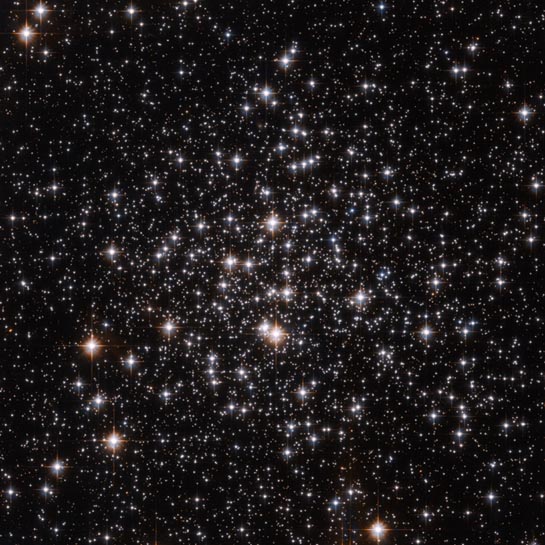
An Unusual Globular Cluster
Globular Star cluster
RA 19h 53m 45.87s Dec 18° 46' 45.72"
Sagitta
13,000 light years
6.1
7.2 arcmin (27 light-years across)
3.36 x 3.39 arcminutes
North is 114.5° left of vertical
ESA/Hubble and NASA
August 23, 2010
ABOUT THIS IMAGE:
This spectacular NASA/ESA Hubble Space Telescope image shows a bright scattering of stars in the small constellation of Sagitta (the Arrow). This is the center of the globular cluster Messier 71, a great ball of ancient stars on the edge of our galaxy around 13,000 light-years from Earth.
Globular clusters are like galactic suburbs, pockets of stars that exist on the edge of major galaxies. These clusters are tightly bound together by their gravitational attraction, hence their spherical shape and their name: globulus means "little sphere" in Latin. Around 150 such globular clusters are known to exist around our Milky Way, each one of them containing several hundred thousand stars. The stars in Messier 71, as is usual in such clusters, are relatively old, at around 9 to 10 billion years, and consequently are low in elements other than hydrogen and helium.
Messier 71 has been known for a long time, having been first spotted in the mid eighteenth century by Swiss astronomer Jean-Philippe Loys de Cheseaux. Cheseaux discovered a number of nebulae in his career, and also spent much time studying religion: one posthumously published work attempted to derive the exact date of Christ's crucifixion from astronomical events noted in the Bible.
Ever since it was discovered in 1746, the nature of M71 has been the subject of some questioning. It has been classified as both an abnormally dense open star cluster and as an unusually loose globular cluster. Because M71 does not seem to have a high concentration of stars at its center, and because the elemental composition of the stars it contains suggests that they are younger than most globular clusters, M71 was initially believed to be an open cluster. In the 1970s, astronomers examined the relationship between the brightness and temperatures of the stars in the cluster. They found a characteristic trend among the stellar population that is unique to globular clusters, so M71 was reclassified as a young, loosely concentrated globular cluster - one of the smallest of its kind.
This picture was created from images taken with the Wide Field Channel of the Advanced Camera for Surveys on Hubble. It is a combination of images taken through yellow (F606W - colored blue) and near-infrared (F814W - colored red) filters. The exposure times were 304 s and 324 s respectively. The field of view is about 3.4 arcminutes across.
M71 is located roughly 13,000 light-years from Earth in the constellation Sagitta. It has an apparent magnitude of 6.1 and appears as a faint patch of light with a pair of binoculars. The cluster is best observed during September.
From Wikipedia:
Messier 71 (also known as M71 or NGC 6838) is a globular cluster in the constellation Sagitta. It was discovered by Philippe Loys de Chéseaux in 1745 and included by Charles Messier in his catalog of comet-like objects in 1780. It was also noted by Koehler at Dresden around 1775.
The star cluster is at a distance of about 12,000 light years away from Earth and spans some 27 light years across. The irregular variable star Z Sagittae is a member of this cluster.
M71
was long thought (until the 1970s) to be a densely packed open cluster
and was classified as such by leading astronomers in the field of star
cluster research due to its lacking a dense central compression, and to
its stars having more "metals" than is usual for an ancient
globular cluster; furthermore, it lacks the RR Lyrae "cluster"
variable stars that are common in most globulars. However, modern photometric
photometry has detected a short "horizontal branch" in the H-R
diagram of M71, which is characteristic of a globular cluster. The shortness
of the branch explains the lacking of the RR Lyrae variables and is due
to the globular's relatively young age of 9-10 billion years. The relative
youth of this globular also explains the abundance of "metals"
in its stars[citation needed]. Hence today M71 is designated as a very
loosely concentrated globular cluster, much like M68 in Hydra. M71 has
a luminosity of around 13,200 Suns.